-
Posts
6,486 -
Joined
-
Last visited
-
Days Won
10
Content Type
Profiles
Forums
Blogs
Gallery
Events
Store
Posts posted by Brian Wolfe
-
-
We spoke of the cone on the chimney and showed the top of the combustion chamber where the smoke and combusted air escapes. Of course it would serve no purpose if all we had was a chimney and no way for fresh air to enter the chamber, remember our combustion requirements tri-angle.
Most of the specimens in the collection provide for entry of fresh air into the chamber. I would have to think that the lamp’s construction, mainly around the door and the light shield (we’ll look at that later on) would provide sufficient draft to provide the flame with oxygen laden air, however, at least in the specimen pictured below this much needed fresh air is supplied via vent holes situated at the back and bottom of the lantern.
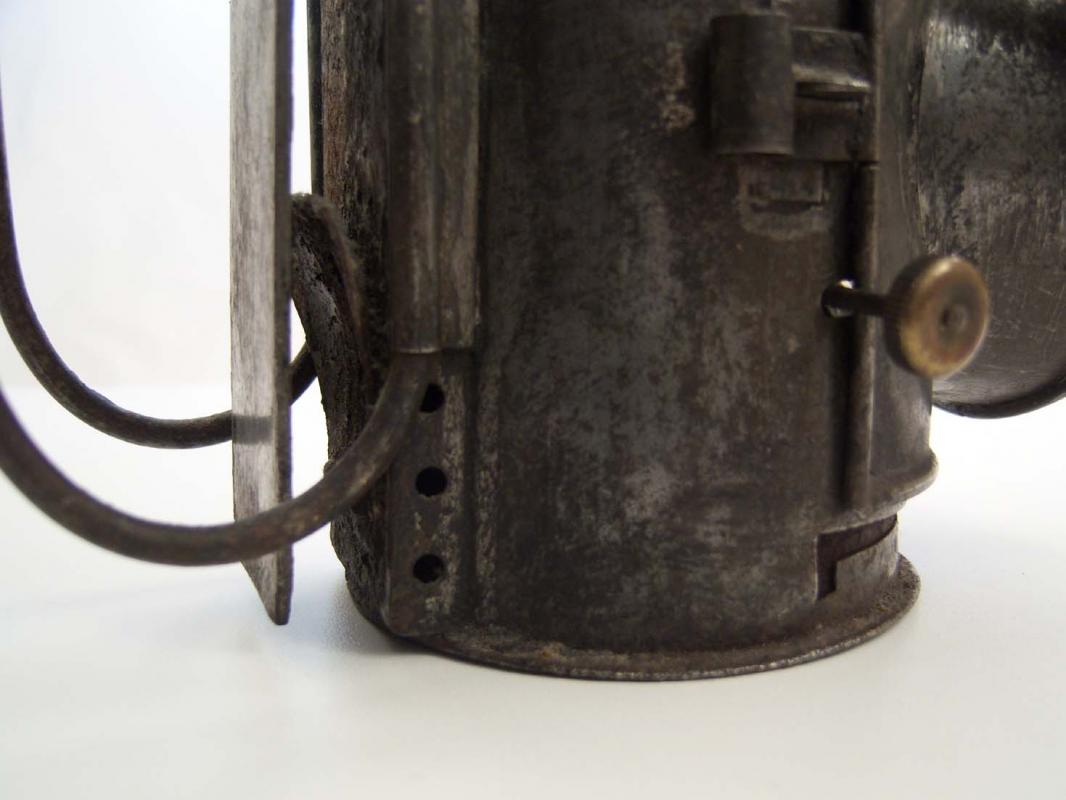 0
0 -
In the collection I have one specimen that requires some repair to the chimney cone and I thought that this was a good time to use it to show the parts usually covered and therefore go unseen.
In the one photo you can see the exterior of the combustion chamber come with the hole at its apex as mentioned in the last post. Over this venting hole is affixed the smoke dispersal cone or cones. In the case shown there are two cones, one above the other. This cone would normally be riveted onto the body of the lantern.
You can see that the lower, or bottom, cone has a hole that corresponds with the one in the top of the combustion chamber. With the addition of extra cones the smoke would be further dissipated upon exit from the lantern. I do not believe the flow of air into the chamber would be increased as the exit hole in the chamber itself is unchanged and the addition of extra cone would not increase or ease the exit of combusted air significantly.

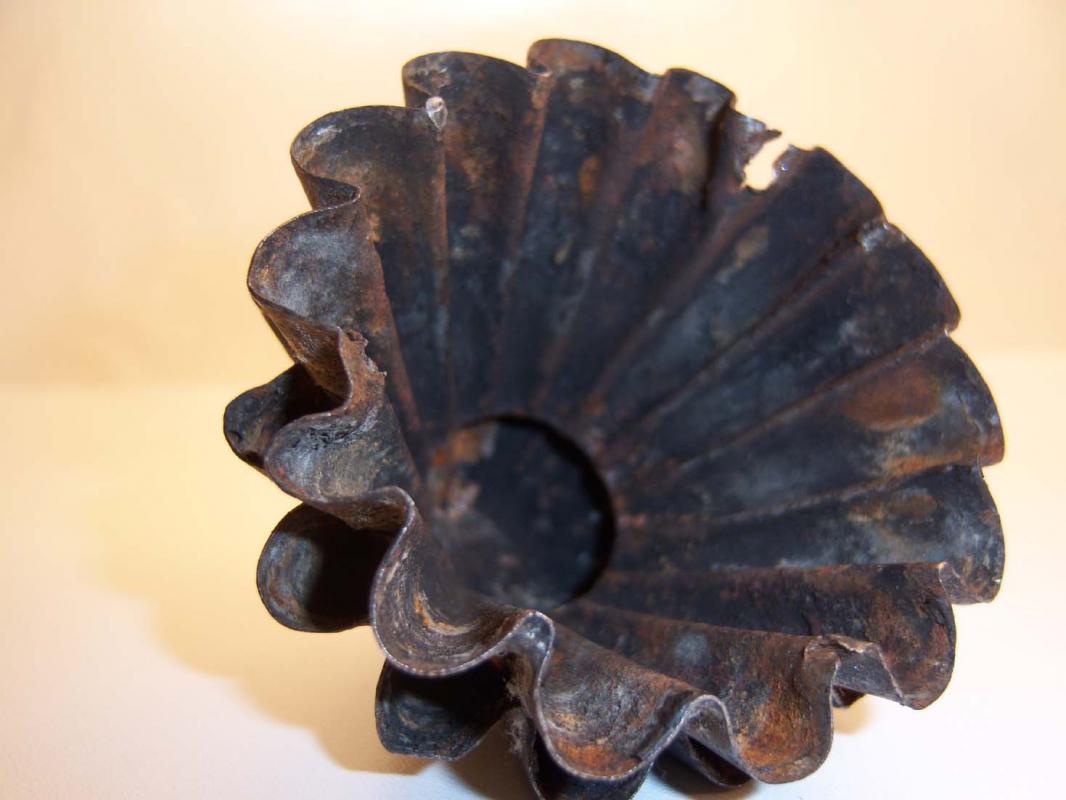 0
0 -
The Lantern Chimney
This time of the year – three days before Christmas – it is most appropriate to be speaking of the chimney, in our case the police lantern’s chimney. One of the basics taught in Fire School is the “Fire Requirements Tri-angle”. To have fire you need three things, air, fuel and heat. Eliminate any one of the three and you no longer have the requirements for fire. This simple equation applies to any situation, including the lantern if a flame is desirable.
The lantern requires air to enter the combustion chamber and therefore also needs a chimney to facilitate the movement of combusted air out of the chamber so that fresh air may be drawn in to satisfy the needs of tri-angle model noted above. It holds true that basically the larger the opening the better the flow of air, or draft; to a point of course. The top of the combustion chamber of a typical lantern is conical with an opening at its apex. In order to dissipate the resulting smoke a cone is placed over the opening in the combustion chamber. There may be as many as three of these cones forming the top of the lantern. Examples of the three different configurations of cone placement are shown below.
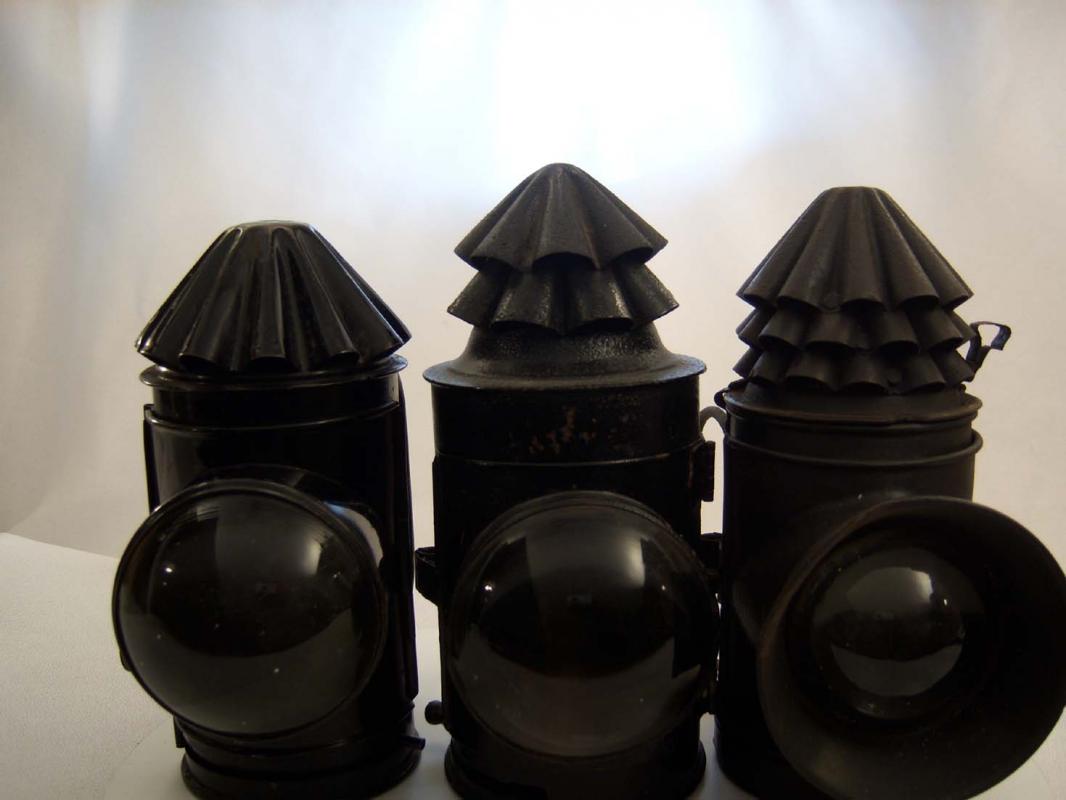 0
0 -
I seldom say that this or that is the best on the market but in this case I know what I am, talking about.
The best reference in the world on bayonets is the now out of print, "Bayonets of the World" a four volume set by Paul Kiesling. It was published by MIlitary Collectors Service, back in 1976. There are highly detailed technical drawings of every basyonet from the days of the plug bayonet to the latest issued weapon (up to 1976). Technical drawings are far superior to photographs in my opinion. With each drawing comes all the statistics you would ever want.
I would suggest that you look at the offerings of the book dealers at your local gun show as these do come up for sale, one at a time usually.
Honestly, this set makes all other references compost.
If you pourchase a bayonet and THEN want an identification be sure to post it on the forum and I'll be glad to research it for you, as will the other members of course.
Regards
Brian
0 -
Nick,
What great possibilities for the issuance of the Golden Kite, considering both the Rosso-Japanese and the later WW I medals are present.
A very interesting group.
Regards
Brian
1 -
You're welcome. They're not pristine as some like to collect; especially in Japanese medals, but they were worn and if only they could talk... ; )
Azyeoman:
I'll take a group of medals that were worn by the recipient over mint specimens any day.
Your medal collection is top notch in my opinion, well done.
I hope there is more to come and if so please let us see them.
Nick:
My eyes are not good enough to see close detail on the Golden Kite. Do you think this is an early issue, maybe Meiji or Tashio period? It looks early to me but I can't be sure from my computer screen.
Regards
Brian
1 -
Hello Azyeoman,
Thank you for posting photos of your collection it is most interesting indeed.
I too would like to see close up photos of your collection.
Regards
Brian
1 -
Hi Monty,
I can see why you like your lamp, it is a nice one indeed.
Looking at the photo of the fellow (you?) holding the lamp makes me want to shout, "Don't go in there!". Where was that photo taken? White Chappel perhaps?
Regards
Brian
0 -
Hello Mervyn,
I believe it is too obsecure a topic to garner much resopnse, however, once completed I hope it will be a good reference for any members, present and future, who might buy one of these interesting items.
There is a period detective show on Canadian television set in Victorian Toronto. The show is called Murdoc Mysteries. The lead actor was shown, in one episode, holding a lit bulls eye lantern, not by the handles, but with his hand wraped around the sides. I would think the real lantern would be too hot to have done this and they probably used a battery powered light in place of the burner for the program. This shows how little people know about such items from our past.
My next series of photos, in a day or so, will deal with the chimneys of the oil burners.
Regards
Brian
0 -
I agree with Matthew on this, obverse 1870/1871 and it looks good to me; matches the ones I have.
Regards
Brian
0 -
Here are a couple of photos showing the interior and the oil burner mentioned above.
Regards
Brian
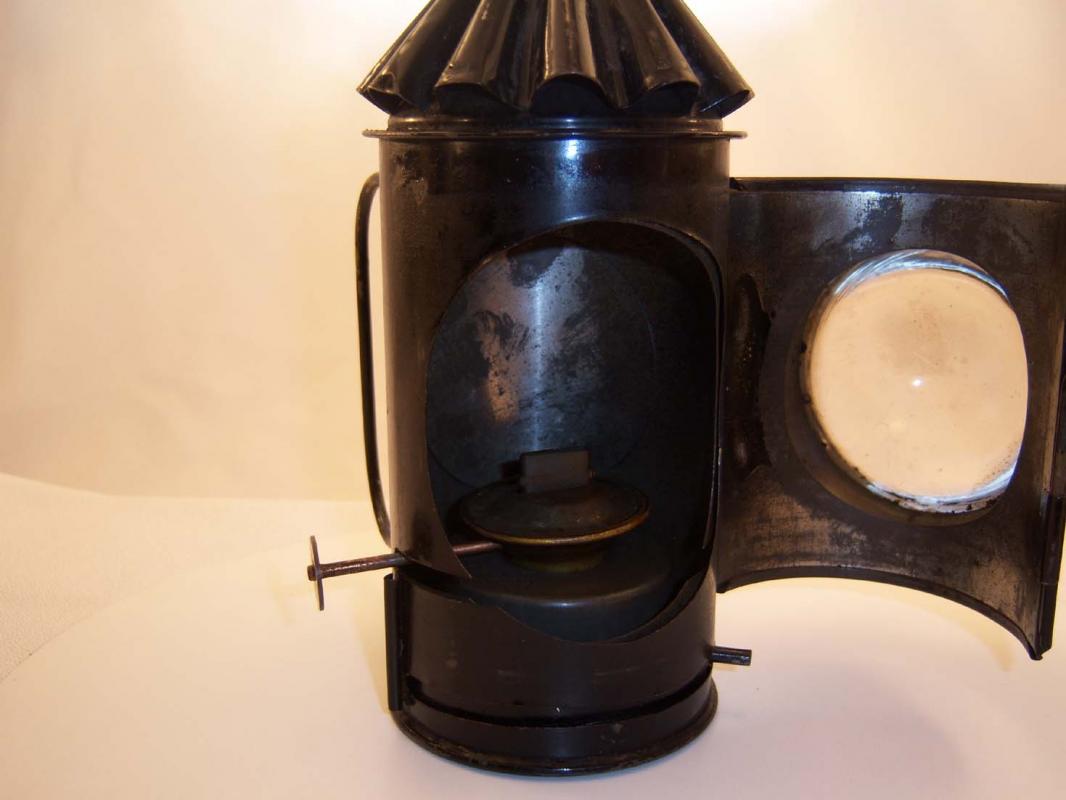
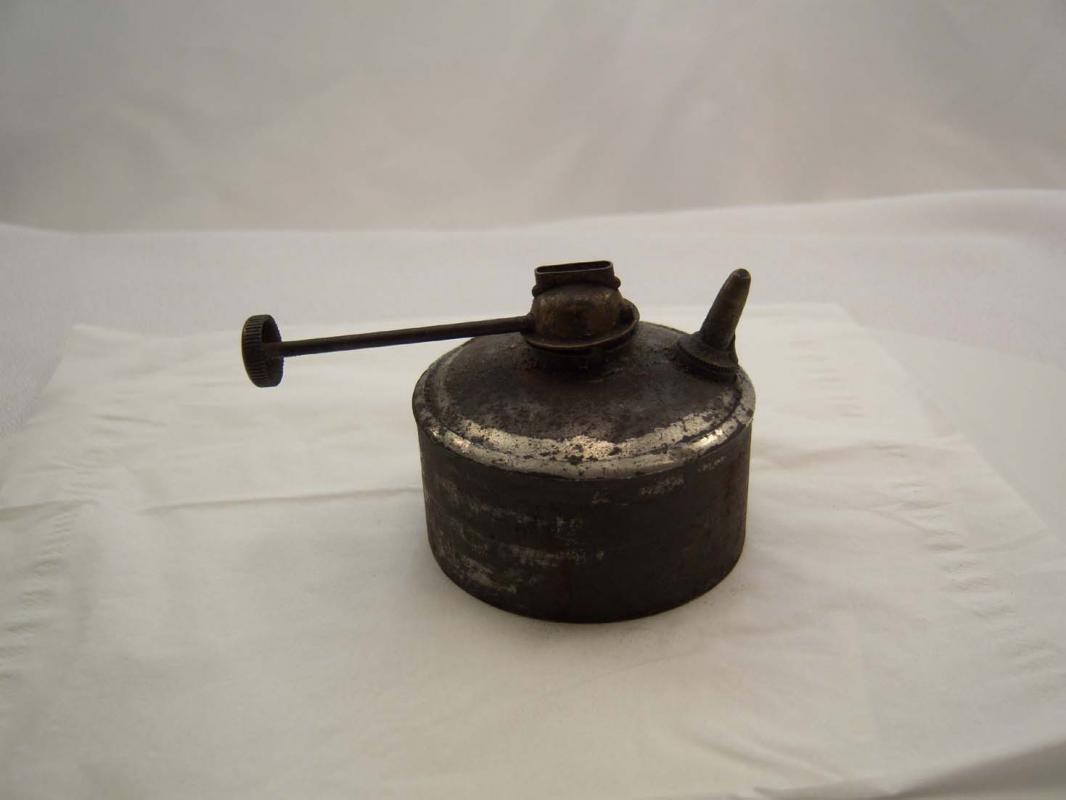 0
0 -
Police Lanterns
I thought we’d spend some time looking at the different features of the typical British Police Lantern. Most of these features were carried through to the early battery powered flashlights, or torches, in one form or another demonstrating just how effective they were.
One of the first things to notice is the glass lens which is convex at the front and flat on the interior side. This magnifies the light considerably and was especially important when the early candle-lit versions were used. I will look at these and other lanterns later on. The term “bulls-eye lamp” came from the appearance of this lens. While I am not showing this next feature in this series of photos there is a sliding metal “screen” that can be used to close off the light without having to extinguish the flame. At the back of the light chamber is a round piece of polished metal used to intensify the light produced and reflecting all of the light possible through the bulls-eye magnifying lens. I think this shows up in the photo, if not then you will see this feature in other examples as we move along.
On this particular lantern you can see the latch that holds the front door, containing the lens, shut. Usually this is a simple strip of metal that snaps over a metal protrusion on the side of the lamp. This one actually slides up and down thereby locking the door closed. The adjustment wheel for the lamp can also be seen where the door meets the body of the lantern. Not all burners had external adjustments, some were simply a burner without a way to adjust the flame and some had the adjustment device on the inside of the lantern. Much depended on the manufacturer’s design.
On the top of the lantern can be seen the vent cap or chimney. These came in single, as in this version, double and even triple cones to produce a taller chimney. Again, I’ll show these later.
On the back are some features that all police lanterns share. The double “D” handles that fold to the sides to allow the belt hook to be employed and, of course, the belt hook itself. This model has a metal bump, indicated by the pointer in the photo to keep the lantern from working its way upward and therefore eventually off the officer’s belt. Anyone who has ever clipped a large carpenter’s tape measure to their belt knows how easily these can work up and off the belt. Ah, for a dollar every time I have had to climb back down the ladder to retrieve that tape measure.
In the last photo you can see a typical oil burner. This is not the one in the lamp featured but it is similar. The first oil burners were unboundedly whale oil but later on they used coal oil also called kerosene. NEVER, as I read on one forum, did they use gasoline (petrol) in these burners. I trust this was a simple slip of the memory or an accidental substitution of the word gasoline for coal oil. Using gasoline in one of these burners would make Molotov proud, as you have just produced an incendiary device.
Keep tuned for more on British Police Lanterns
Regards
Brian

 0
0 -
The iconic lantern
We see so many things in our world that are considered as iconic. Staying with the theme of this post; when people all over the world think of the British Bobby what do their mind’s eye envision? They probably think of a police helmet (sometimes called a custodian helmet), perhaps the famous cylindrical whistle and maybe even a truncheon, or night stick. I doubt police lantern comes to mind, yet during my research into the historical background for this post the opposite seems to be the case, at least in the past. Comical post cards, advertisements for all kinds of products and honour roll documents abound with depictions of the police officer holding his trusty lantern. As we progress through this post I will show such examples of what I am talking about.
Mervyn has covered the history of lanterns very well in the opening post so I will try not to repeat it. Like Mervyn I am only going to deal with British lantern and later early flashlights. The common features that differ between police and civilian lanterns and later the early flashlights is that the lanterns often have a convex lens, thereby coining the term “bulls eye lamp”. In addition to this they have a double handle at on the back along with a wide hook to fasten it onto the officer’s belt. Some lamps have a second hook-like feature to keep the lamp from working its way up and off the belt. Another feature is a device to shut the light off without requiring the lamp to be extinguished. I will show some example as we go along.
On the older lamps one of the features that stands out, to my eye at least, is a cone- shaped chimney. These can be single or stacked one on the other up to three high. These chimneys are common to all fuel burning lanterns and not just police issue.
I’m not sure that Mervyn covered this point earlier but in his book, “The Policeman’s Lot” it tells of policemen holding the lit lantern under their cloaks, or capes, in order to stay warm on cold damp winter nights. Many times, Mervyn writes, the officer would return to the station at the end of his shift with his face blackened by soot produced by the burning fuel in the lamp. A note regarding Mervyn’s book, if you don’t have one, get one. The information is invaluable. Contact Mervyn for details.
Now to move past that shameless plug for Mervyn’s book; I will post an early candle burning lantern that would have been used just after the one Mervyn sent me photos of and I botched them by getting the size of the photos too small. My apologies.
Watch this space for more on Police Lanterns in the future.
Regards
Brian
0 -
Hello Graeme,
I've been in contact with a good friend in India just a few weeks ago and he mantioned that the site was a bit slow but gave no indication that it has been disbanded.
Since, as in the case of many forums, one person owns the site I suppose it could have been closed down.
Perhaps other members can shed some light on this?
Regards
Brian
0 -
Hello Stephen,
Indeed you should be well pleased with this grouping, very nice.
It just adds to my belief that the Specials were often people who were totally dedicated to serving their country and municipality not only in times of peace but also during times of war.
Thank you for posting this most interesting addition to your collection.
Regards
Brian
0 -
Thanks for the example of the lantern. I wonder if these were ever used by the rural area police services back when glass was too expensive.
RE: FIres.
So true Peter. In the past if a fellow lit up a cigarette while in a barn you knew he was not from the country. No one raised on a farm would think of such a thing as striking a match in a barn. It makes me laugh when I see a movie or television show where the actors have no hesitation in lighting up a cigarette in a stable while trying to look ever so tough. They may be portraying a tough gut but unknowingly also a very stupid man.
The 21st is the end of the world? No matter, as there are three large gun show near us (Orangeville, Jerseyville and Woodstock) on the 2nd, 9th and 16th so the 21st will be just fine.

Too bad that, for the most part, the shows are all cash only.
Regards
Brian
0 -
The first true lanterns were lit by candle and photos of an example is provided by Mervyn. He informs me that this lantern is a police lantern dating from the 1850’s and was used by a Sergeant with the village of Bentley in Hampshire. While on duty the sergeant died when a wasp flew into his mouth causing him to choke to death.
The early candle lanterns were called Lanthorns. Glass was rare in those early days so the light panels were made from cow’s horn. Candles were quite expensive so they tended to use rolled wick dipped in animal fat. Here in Canada we quite often see demonstrations at pioneer villages of candle “dipping” in which several wicks are hung from a stick and then the wick repeatedly dipped into animal fat. After many “dippings” the fat, or tallow, builds up to produce a candle. These candle tend to give off a very greasy black soot when burned.

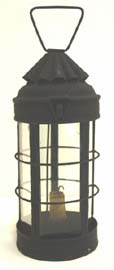 0
0 -
Shedding Light on the Crime; not a bedtime story.
Abysmal was the only word to describe this moonless overcast autumn night. The neighbourhood had been forgotten by society, polite society that is. The street lights were old and outdated. New lights found in the up-scale areas would never see this neighbourhood, not even when they were felt to be out of style. The lights would be sold to smaller municipalities; never to be installed here. Many of the lights were out, shot out by pellet guns making the darkness here purposeful and with an intent repulsive to gentler folk. This the city planners called “Urban Blight”, however in more knowledgeable circles where actual “doing” was the norm was whispered a different term. “Ghettoization of the Poor” was the term bantered around, a purposeful concentration of those less fortunate to serve as fodder, victims if you will, to the criminal element. After all as long as you can ignore an area in decline thereby creating a hunting ground for the wolves of society the chances are less likely that they will ply their trade in the white bread world of “up-town”. This is nothing new and every city has their Cedar Street, corner of St. Ledger and Young and “Shooters Lane”. This will never change as high speed commuter train systems are more important than the welfare of our fellow man. It truly is still a Dickensian world.
Along with the blinded street lights very little other light was visible short of the odd window through which an eerie sporadic pulsating glow emitted from a television set. One or two upstairs windows were lit up and there existed hope that in the room was a small desk with a young child who was pouring over his or her lessons with the slight hope of earning their way out of this cess pool. Experience, however, told a different likelihood. That of a single mattress thrown on the floor where a lady of the evening carried on her so-called trade in order to earn just enough for the next hit of crack, smoked using a crushed soda can as a pipe and a butane cigarette lighter as the ignition source. She was old before her time, even though she was barely out of her teens, just more collateral damage in the political gaming circles.
The house in question had long past being described as run down and old. It was an ancient pile or half rotten timbers and broken window panes awaiting the caress of the arson’s touch. A sure fate when the property became more valuable than the rent squeezed by the slumlord from these poor retches. Still it was someone’s home and castle, their refuge from the greater decay looming all around in the darkness. Paint had long since given up trying to make a home on the building’s exterior and what did still reside there was in flakes peeling off as if it too were trying to follow after its comrades to a better existence. The front steps had long since given up being even close to horizontal and the wooden treads were bowed downwards as if the stress of thousands of desperate souls treading on them had been too depressing for them and they now just existed without the will to live. Under the porch could be heard a rustling scurrying sound of creatures best left unseen and unmolested least their unwanted attentions be turned loose on the inquisitive interloper. On the corner of the porch next to a very narrow unpaved driveway, was a square-based tapering pillar holding up the porch roof with the house number 23 affixed to it. The letters had been of good quality at one time, enameled white letters on a metal base. Now they were missing much of the enameling with what was left being stained yellow by the rusting medal. Under the letters was nailed a board with little to no regard to right angles or even an attempt to be slightly horizontal. On the board was scrawled the words, “23½ ROUND BACK!” by someone obviously sick and tired of being inconvenienced to give out directions to 23½.
“Why is it always ‘round back?”
The driveway was put in long after the house had been built, before Henry Ford’s creations, constructed to accommodate the Model T or Model A automobiles of the day. It had gone unused due to its lack of width through the craze for super sized automobiles and the muscle cars. A Smart Car would now fit but that would never be seen in this neighbourhood. The driveway was equally dark and uninviting ending with a dilapidated garage, more than a mate for the ailing house. The sill had long ago rotted away and the vertical wood siding was now all that held the structure erect. The sides themselves bowed out leaving the structure resembling a circus tent more than an accessory building.
The sound of a dog barking in the distance could be heard but it sounded to be a few doors over. No barking came from this property in response to the other dog’s challenge so that may not be an issue here.
“At least it’s not the end of the shift.”
There was a superstition among the officers in the division that if all went well for your whole shift then the last call was likely going to be the most dangerous. If you were going to “buy it” then that was when it would happen. This caution was probably started to keep the new officers on their toes. As the biggest factor in any officer’s injury or death is quite often complacency.
Taking a deep breath the summons firmly in the officer’s leather encased Kevlar gloved left hand, he drew his right hand back past the Asp (extendable baton), undoing the dome on his 9 mil. holster and finally coming to resting on his three-cell Mag-Lite. He preferred the Mag over the stronger beam of the mini flashlights carried by some of the younger officers. The reason was simple, deadly simple. A Mag might not be able to blind a charging rhino or fry ants at fifty feet such as the young officers bragged about their mini lights, but it gave sufficient light and could serve, as it had on several occasions, as a defensive “weapon of opportunity”. Here is the simple logic. When something “goes down” you have 1.5 seconds to react. So, 1.5 seconds to drop your mini flashlight, un-holster your 9 mill (did you remember to unfasten it earlier?), snap off the safety, point it at the assailant and come up with a memorable line out of a Dirty Harry or Rambo movie and save your butt. All in 1.5 seconds...won’t happen sweetheart! At least with the Mag-Lite in hand you have something, well, at hand, what you do in the next 1.5 seconds is up to you.
“Thank God for my Mag-Lite”
The officer had seen just about every kind of trap and trip fall over the years. From boards with nails protruding waiting like some spiny sea urchin in the dark waters of night, to impale any unwary pedestrian venturing into their domain, to trip wires set across the top of exterior basement access stairways. The lights at the bottom of these egress wells were always “conveniently” out of order. The one that always stuck in his mind was one basement apartment access stairs, as usual in complete darkness, that had a row of soda cans sitting along the front edge of one of the treads, about one half way down the stair case. Stepping on top one or two of these cans would send you down the stairs on your backside in a flash. The worst were concrete stair cases. Then there were the “screamers”. Battery powered alarms that emitted a sharp whine so loud as to nearly split an ear drum and the fright enough to bring on a heart attack, or at least it seemed so. These were attached to one side of the stair case, a monofilament line stretched across the stair way. These were activated similar to a hand grenade with a pin being pulled out when someone tripped the line. If there was one thing in abundance in this neighbourhood it was human ingenuity, whether protective or malicious.
Reaching the back corner of the main house there was a smaller structure attached, probably a former kitchen with accommodation for the “help” dating back to more affluent times. The porch light was off but the window beside the door was lit up. As he scanned the property and especially the path to the door he noticed that the only potential traps were those of children’s toys reluctantly left when “time for bed” was announced. He could imagine the protests of the young adventurers as their mother put an end to their conquests of the imagined castle or the slaying of the evil dragon. Some things common to children everywhere is their ability to ignore brutal reality in favour of their own worlds of make believe. This made him smile slightly.
Reaching the entrance the officer opened the screen door and knocked on the old paint cracked wooden slab. He actually lightly kicked the door with the toe of his shoe but it was still a knock. Immediately the light was turned off that had illuminated the window and the porch light was snapped on. The officer instinctively shut the screen door which he braced closed with his foot; toe on the door and heel firmly against the decking of the porch. This was the moment of truth, the seconds before the bull charges the matador or the moment before when all is revealed, the expected raging bull or a peaceful member of the heard.
A woman opened the door; it was hard to tell her age due to the lack of light as she stayed in the shadows afforded by the frame of the screen door. It didn’t matter at this time as the officer could see that she held nothing in her hands and shining the flashlight’s beam in her face would only serve to annoy more than identify..at least for the time being.
“Is Mr. Larry Oatman living at this address?”
“Yes, I’m his wife”, she offered without hesitation and offered her full name and date of birth following the officer’s request.
“Please give this to him” the officer calmly said in a helpful tone of voice practised to garner cooperation.
“What is this?” She queried as she instinctively reached out and took the document. This happens more than not when serving a summons which is helpful though in Canada there is no need to actually touch the person with the summons to complete service.
“It’s a Summons for Mr. Oatman to appear in court”
She accepted this with a look of someone familiar with the term recidivism; the cycle of conviction followed by incarceration, release and another crime leading to arrest and conviction. This time all went down smoothly and peacefully. It is not always so, but one needs to be thankful for small favours and not dwell on the times when you’re met with violence.
Back in the patrol car the officer couldn’t help but think that this cycle of crime, incarceration, release then crime was like the instructions, wash, rinse, and repeat on the label on a shampoo bottle being applied to life. He also couldn’t help but wonder if this was always going to be the case for many in this part of the city. Deep down he knew the answer to his own question.
This is a scenario played out over and over day after day year after year all over the country. In most cases there is no need for a firearm, the asp is not drawn or the pepper spay not released into an assailant’s eyes. However it’s the trusty old flashlight that is employed repeatedly. So it has been since the days of the watchmen with their burning brands, or torches, the candle lit lamps followed in time by oil fueled and then to battery powered lights, shedding light on crime and making it safer for officers to carry out their duties.
Watch this space for more on this subject as time goes by with specimens from the Victorian Period to more resent times.
Regards
Brian
0 -
A shot of the front of the knuckel bow and the manufacturer's trade mark, which is fairly common.
I've always said that value was secondary to me but in this case I don't want to cheat a friend or pay twice what it is worth out of my own ignorance. This fellow and I haunt gunshows together so a fair offer is even more importantfor both of us.
Regards and thanks again.
Brian
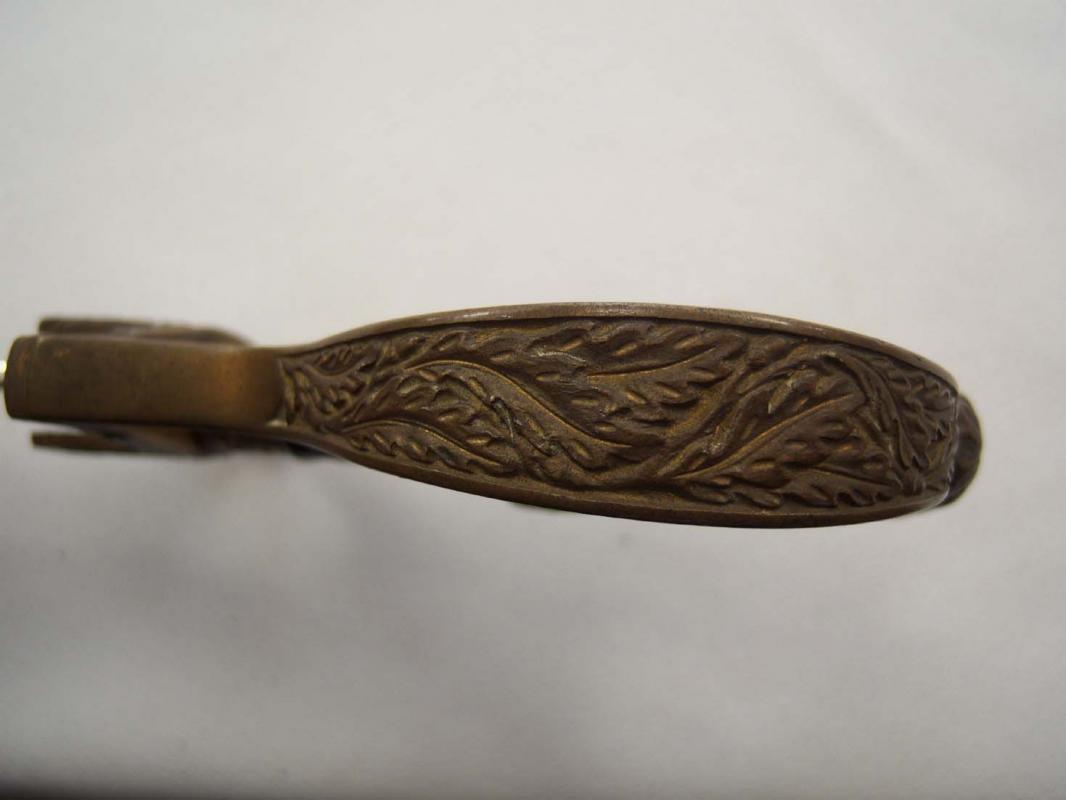
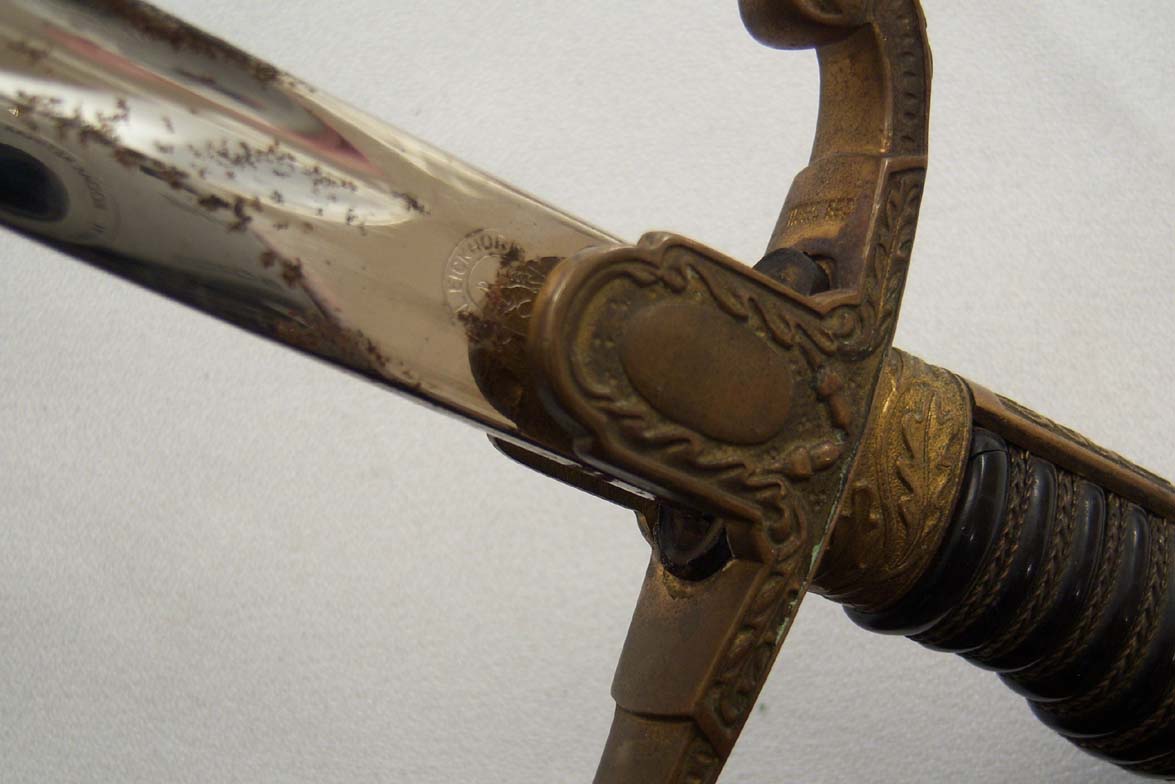 0
0 -
Sorry the image was too large to show both sides on the last post.
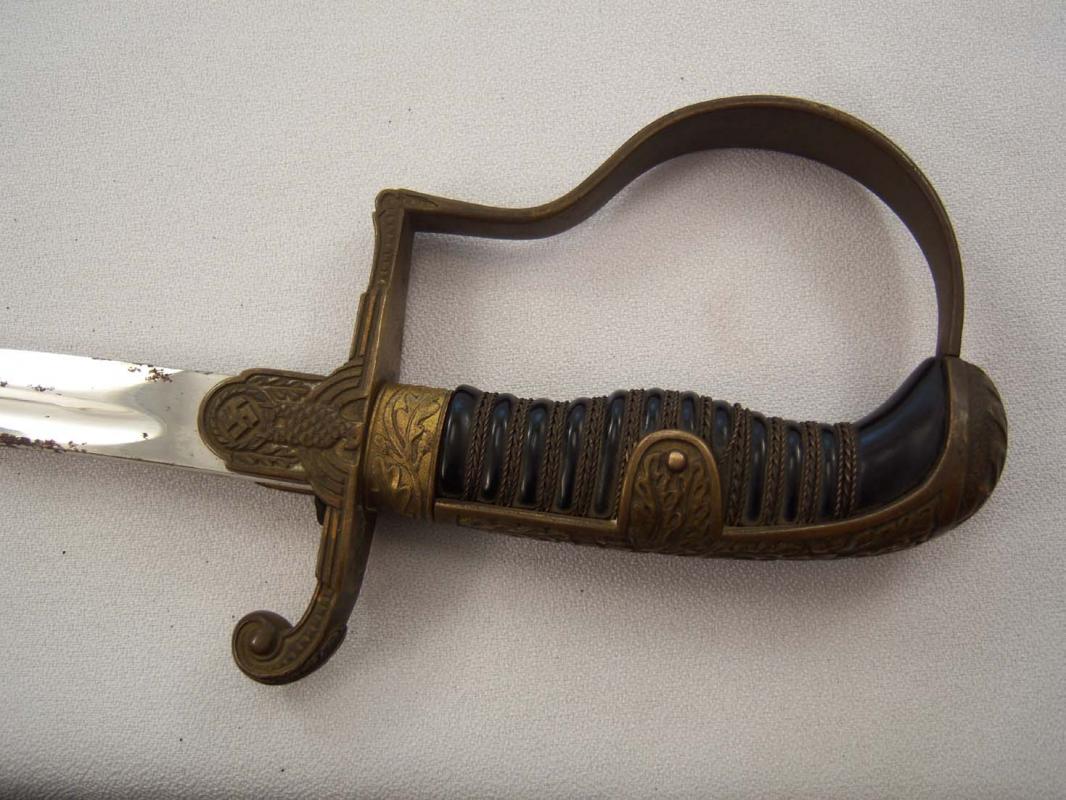
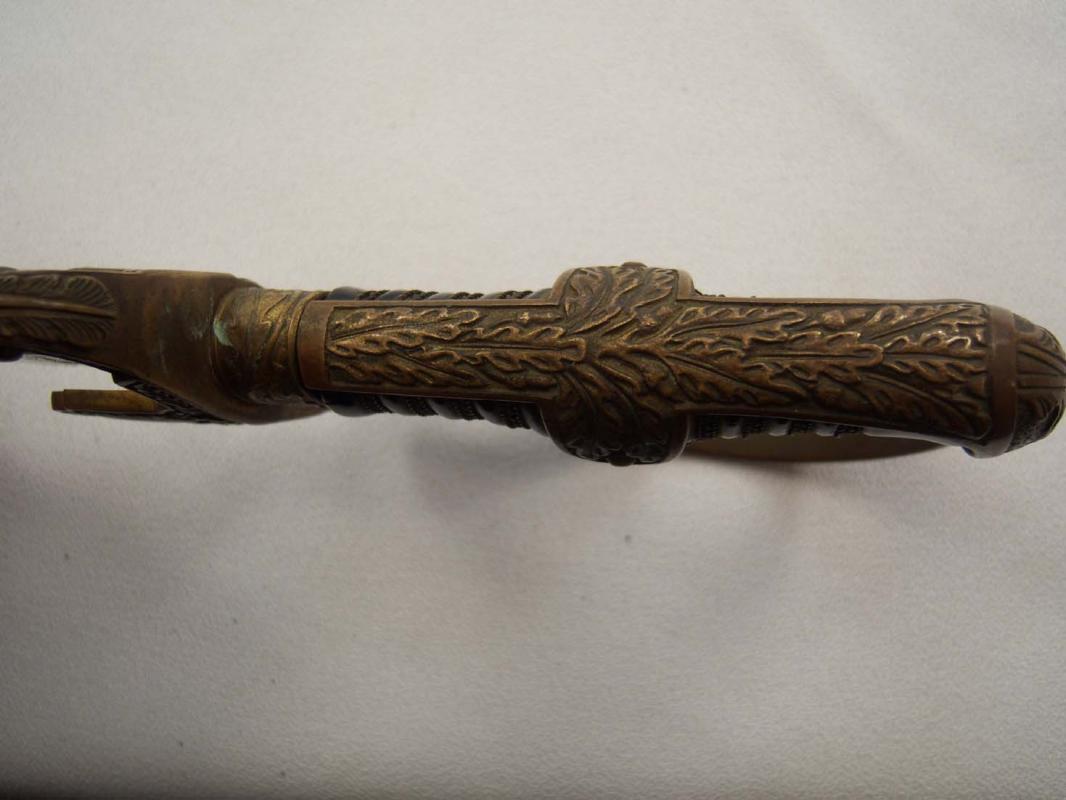 0
0 -
Here are some shots of the hilt.
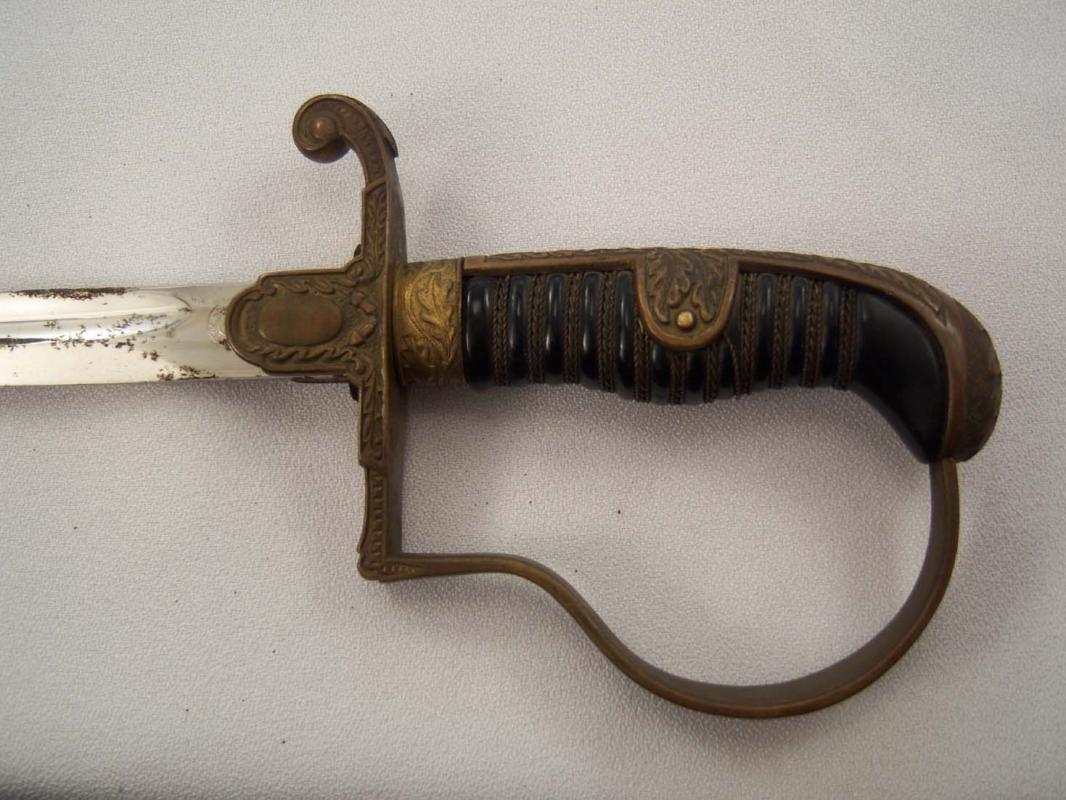 0
0 -
Third Reich Parade Sword.
A friend of mine brought in this Third Reich period sword that his late father brought back from WWII. He’s not sure if he wants to keep it or not and since it has been years since I purchased any German swords I have no idea of the value
There is light pitting all along blued steel scabbard and quite deep rusted areas along the six inches of the blade just above the hand guard. I’ve seen this many times with swords brought back from the wars and then stored in the closet for decades.
Any help with the identification and value would be appreciated. I’m looking for a value between dealer’s table-price and wholesale so that if he decides to sell I can make him an offer fair to both of us.
I’ve tried to show the manufacturer’s mark in the last photo.
Thanks again for any assistance you can give me.
Regards
Brian
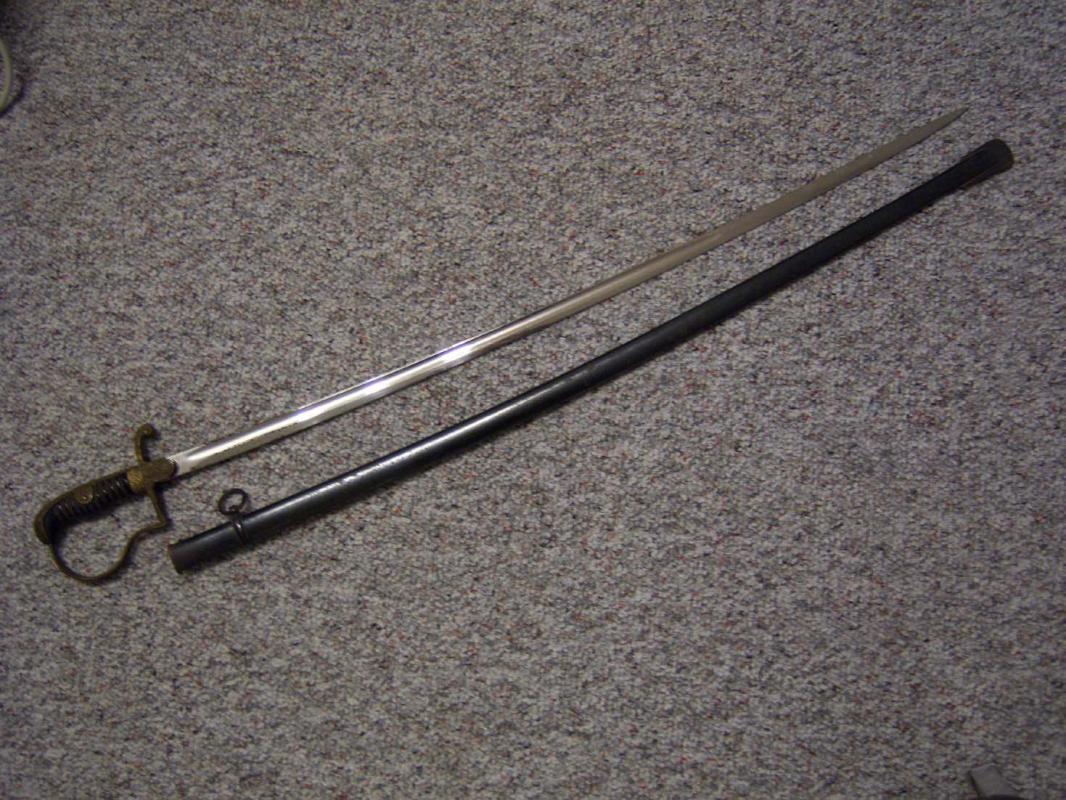 0
0 -
Welcome to the forum Chris.
Regards
Brian
0 -
A most interesting post, Mervyn, thanks for taking the time to share thses photos with us.
Regards
Brian
0




British Police Lanterns
in Great Britain: Mervyn Mitton's British & Colonial Police Forces
Posted
Before we move on from the chimney topic I would like to show a different idea in the configuration of a chimney.
This lantern was designed by a policeman with the needs of a constable in mind, as he saw it. I will feature the lamp on its own later but I wanted to show the interesting chimney on his design. The lamp itself has several design changes, I would classify as improvements, over the standard lantern of the day, therefore I will give it special attention later on in this series.